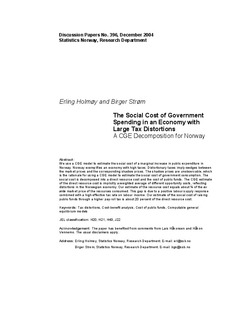The Social cost of government spending in an economy with large tax distortions. A CGE decomposition for Norway
Working paper

Åpne
Permanent lenke
http://hdl.handle.net/11250/180421Utgivelsesdato
2004Metadata
Vis full innførselSamlinger
- Discussion Papers [1003]
Sammendrag
Abstract:
We use a CGE model to estimate the social cost of a marginal increase in public expenditure in
Norway. Norway exemplifies an economy with high taxes. Distortionary taxes imply wedges between
the market prices and the corresponding shadow prices. The shadow prices are unobservable, which
is the rationale for using a CGE model to estimate the social cost of government consumption. The
social cost is decomposed into a direct resource cost and the cost of public funds. The CGE estimate
of the direct resource cost is implicitly a weighted average of different opportunity costs, reflecting
distortions in the Norwegian economy. Our estimate of the resource cost equals about ¾ of the ex
ante market price of the resources consumed. This gap is due to a positive labour supply response
combined with a high effective tax rate on labour income. Our estimate of the social cost of raising
public funds through a higher pay-roll tax is about 20 percent of the direct resource cost.
Keywords: Tax distortions, Cost-benefit analysis, Cost of public funds, Computable general
equilibrium models